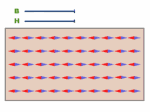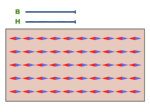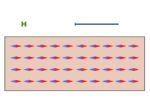MAGNETIC PHENOMENA IN FERROMAGNETIC MATERIALS
|
MAGNETIC PHENOMENA IN FERROMAGNETIC MATERIALS |
Ferromagnetism is one of magnetic state of the substances characterized by parallel orientation of the magnetic moments of nuclear carriers of magnetism. It is caused by positive value of energy of inter-electronic exchange interaction. The magnetic permeability of ferromagnetic materials is positive and reaches values of about 105 G/Oe. Their magnetization J grows with increase of magnetic field Н not linearly and achieves a limit value Js (magnetic saturation). Value J depends also on "magnetic history" of a sample. It makes dependence J on Н ambiguous, so the magnetic hysteresis curve is observed.
Ferromagnetic hysteresis curve (loop) characterized by several parameters: coercivity, remanence (or remanent magnetization), magnetization of saturation, maximum energy product (or strength of the magnet). Coercitivity Hc is the field which has to be applied to ferromagnetic material to make magnetization equal to zero. High coercitivity is very important for permanent magnets to stay magnetized in the presence of an opposing magnetic field. On the contrary for magnetic transformers the big coercitivity is harmful because it increases the lost of energy. Remanence is residual magnetization of a ferromagnetic material in the absence of external magnetic fields (after the external magnetizing field has been turned off). This parameter is convenient to use for comparison of the relative “strength” of different magnets. It depends greatly on magnet composition and method of manufacture. Magnetization of saturation is magnetization of ferromagnetic material in very strong (infinity strong) magnetic fields. All the atoms in this case are magnetized in one direction. Strength of the magnet is the area of hysteresis loop. This gives a measure of the energy stored in the magnet. The usual unit is the Mega Gauss-Oersted (MGOe). The SI unit is kJ/m3. [1 MGOe = 8 kJ/m3].
Iron, nickel, cobalt, some of the rare earths (gadolinium, dysprosium) exhibit ferromagnetic properties. Most of these materials have poly-crystalline form. Samarium and neodynium in alloys with cobalt have been used to fabricate very strong rare-earth magnets. Such magnets have very high coercivity, remanence, maximum energy product. On the contrary some of amorphous (non-crystalline) ferromagnetic metallic alloys exhibit low coercivity, low hysteresis loss and high permeability. Such amorphous alloys can be fabricated by very rapid quenching (cooling) of a liquid alloy (usually Fe, Co, or Ni with B, C, Si, P, or Al). One example of such an amorphous alloy is Fe80B20 (Metglas 2605).
Ferromagnetism is a so-called cooperative phenomenon, as single atoms cannot exhibit ferromagnetism, but once a certain number of atoms are bound together in solid form, ferromagnetic properties arise. If a ferromagnetic material is cooled from above the Curie temperature, microscopic domains with nonzero magnetization form. Domains are spontaneously magnetized up to saturation. They usually have linear sizes of about 10-3-10-2 cm. The Curie temperature gives an idea of the amount of energy takes to break up the long-range ordering in the material. The Curie temperature of iron is about 1043 K, which corresponds to the thermal energy of about 0.135 eV.
 In absence of an external magnetic field the magnetization vectors of the different domains are oriented in opposite directions, so the net magnetization of the material is zero. Such domain configuration diminishes the energy of magnetic field generated by ferromagnetic material in external space. The direction of vectors of domains magnetization coincides usually with a direction of
easy magnetization axes, that provides the minimum of free energy of ferromagnetic material. If the size of ferromagnetic material is less then a critical size, then splitting into domains can become energetically unprofitable and one-domain structure is formed. Such case is shown in animation (each
arrow represents one magnetic domain). In practice such case can be realized in ferromagnetic films and amorphous alloys. If the axis of easy magnetization coincides with a direction of applied field H, then magnetization occurs by means of domain walls motion. Thus, if an external magnetic field is increased in the direction opposite to material magnetization, then the flip of magnetization occurs sharply when
H=Ha , where Ha is a value of anisotropy field. The rectangular hysteresis loop is observed and coercivity
Hc equals to Ha.
In absence of an external magnetic field the magnetization vectors of the different domains are oriented in opposite directions, so the net magnetization of the material is zero. Such domain configuration diminishes the energy of magnetic field generated by ferromagnetic material in external space. The direction of vectors of domains magnetization coincides usually with a direction of
easy magnetization axes, that provides the minimum of free energy of ferromagnetic material. If the size of ferromagnetic material is less then a critical size, then splitting into domains can become energetically unprofitable and one-domain structure is formed. Such case is shown in animation (each
arrow represents one magnetic domain). In practice such case can be realized in ferromagnetic films and amorphous alloys. If the axis of easy magnetization coincides with a direction of applied field H, then magnetization occurs by means of domain walls motion. Thus, if an external magnetic field is increased in the direction opposite to material magnetization, then the flip of magnetization occurs sharply when
H=Ha , where Ha is a value of anisotropy field. The rectangular hysteresis loop is observed and coercivity
Hc equals to Ha.
 In a case when the axis of easy magnetization is perpendicular to applied field H, the magnetization occurs by domains rotation and linear hysteresis loop observed. Such ferromagnetic materials can be used in measuring systems and transformers since their magnetization is directly proportional to applied magnetic field (or, for example, to a current in primary windings of a transformer). In such ferromagnetic materials the effect of
Young's modulus change under action of magnetic field (DE-effect) is observed. In amorphous alloys, for example, this effect can be great enough (Young modulus can be varied an order of magnitude by magnetic field).
In a case when the axis of easy magnetization is perpendicular to applied field H, the magnetization occurs by domains rotation and linear hysteresis loop observed. Such ferromagnetic materials can be used in measuring systems and transformers since their magnetization is directly proportional to applied magnetic field (or, for example, to a current in primary windings of a transformer). In such ferromagnetic materials the effect of
Young's modulus change under action of magnetic field (DE-effect) is observed. In amorphous alloys, for example, this effect can be great enough (Young modulus can be varied an order of magnitude by magnetic field).
 Two nearest
domains magnetized in opposite directions are always separated by a transitive layer of final thickness (Bloch Wall) in which there is a gradual turn of spins as it is shown in animation. Generally the magnetization of ferromagnetic materials occurs both by means of domains rotation and motion of domain walls. Presence of impurities in a magnetic material, defects of a crystal lattice, various sorts of
nonuniformity complicates the movement of Bloch walls and by that raises the coercitivity Hc of a material.
Two nearest
domains magnetized in opposite directions are always separated by a transitive layer of final thickness (Bloch Wall) in which there is a gradual turn of spins as it is shown in animation. Generally the magnetization of ferromagnetic materials occurs both by means of domains rotation and motion of domain walls. Presence of impurities in a magnetic material, defects of a crystal lattice, various sorts of
nonuniformity complicates the movement of Bloch walls and by that raises the coercitivity Hc of a material.
 Magnetostriction is a change of the form and the sizes of a
ferromagnetic material during magnetization. This phenomenon was discovered in 1842. In such ferromagnetic materials as Fe, Ni, Co,
in a number of alloys and ferrites the magnetostriction can achieve significant value (of about
10-6-10-2). Animation shows a strip domain structure with an axis of easy magnetization perpendicular to
applied field H. Magnetization is accompanied by rotation of domains that results in change of the size of a magnetic material (magnetostriction). Magnetostriction has a wide range of applications in techniques. This phenomenon underlies
magnetostriction converters and relay lines, generators and receivers of ultrasound, filters and stabilizers of frequency, etc.
Magnetostriction is a change of the form and the sizes of a
ferromagnetic material during magnetization. This phenomenon was discovered in 1842. In such ferromagnetic materials as Fe, Ni, Co,
in a number of alloys and ferrites the magnetostriction can achieve significant value (of about
10-6-10-2). Animation shows a strip domain structure with an axis of easy magnetization perpendicular to
applied field H. Magnetization is accompanied by rotation of domains that results in change of the size of a magnetic material (magnetostriction). Magnetostriction has a wide range of applications in techniques. This phenomenon underlies
magnetostriction converters and relay lines, generators and receivers of ultrasound, filters and stabilizers of frequency, etc.